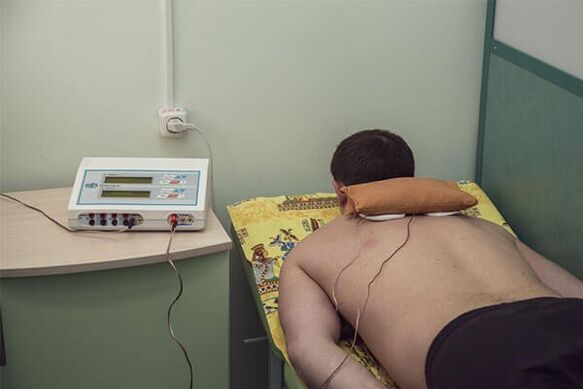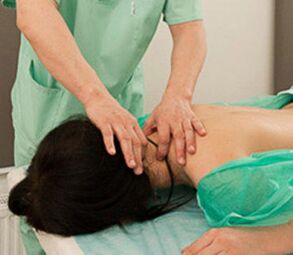Osteochondrosis is degenerative-dystrophic diseases in the cartilage tissue of the band fire joints and causes their deformation and destruction.Osteochondrosis can develop on one or more spine.Osteochondrosis of the cervix regionIt occurs particularly often and sometimes gives very serious complications.

Features of osteochondrosis of the cervical spine
Due to the characteristics of the structure of the cervical spine, the course and the symptoms of osteochondrosis have a number of characteristics in this segment.The cervical spine consists of small moving vertebrae, which are constantly exposed to considerable and long loads.The vertebral canal in the neck area is the closest, so the compression of the spinal cord in this segment develops much more often and leads to rather difficult lesions.In the neck there is a large accumulation of nerve endings and blood vessels, including the vertebral artery, which delivers the diet of the cerebellum, the long brain and the back of the brain.The violation of blood flow in this artery leads to an impairment of the coordination, dizziness, reducing vision and hearing and in severe cases, a stroke can develop.
Symptoms of osteochondrosis of the cervical spine
Osteochondrosis of the cervix regionThe spine manifests itself in several syndromes:
-
Reflex and Irite Syndrome
Burning pain in the cervical and consuming region that occur according to sneezing, sudden movements of the head or a long static state, for example after going to bed or a firm state and subsequent movement of the head or the neck complaints with osteochondrosis of the cervical wave.Pain can shine to the shoulder or breast cage. The narrowing syndrome of the vertebral canal (stenosis of the vertebral canal)
This syndrome develops as a result of compression (bruising) of the spinal cord and its vessels, which leads to circulatory diseases in the affected area and the development of myelopathy - a rare but most impressive complication of osteochondrosis.The Verton -Carbon -Zervical myelopathy mainly occurs in medium and older people, which occur due to the compression of the spinal cord or its vessels with the rear osteophytes, thickened yellow ligament, hernias of the intervertebral discs between vertebral storms, hernias of the intervertebral discs.The disease gradually develops, initially pain and restrictions on movements in the cervical spine are often observed.In the future, cervical osteochondrosis can cause impaired functions of the upper and/or lower extremities, which are manifested by deafness, a feeling of tingling in the fingers, a feeling of cotton legs or weapons to the development of paresis and paralysis-
Rook syndrome
The manifestations of the radicular syndrome in osteochondrosis of the cervical spine depend on the compression caused by structural changes in the disc.In any case, however, cervical osteochondrosis occurs with headaches that have a painful, pulsating or burning character that sometimes flows into the type of hypertension.Back pain is rarely locally locally and usually give the shoulder blades, the forearm, the shoulder and/or hand to the fingers of the brush.
Depending on the affected spine segment, the following symptoms can be:
- C1-C2: The defeat in this segment usually occurs as a result of automotive injuries and shows itself through a violation of the smell and language, the hypotrophy of the facial and sublingual muscles and a decrease in sensitivity in the sub-region.
- C2-C3: It is also rarely affected and is accompanied by the impairment of hearing, seeing and control of the movement and sensitivity of the muscles of language, which leads to language disorders and sensations of taste, the appearance of a feeling of inflammation, sweat or lump in the throat.
- C3-C4: Since the diaphragm nerve in this segment, in addition to pain in the collarbone and the shoulder GPU, withdraws in this segment, spam of the belt and trapezoidal muscles, pain in the right hypochondrium and heart are also developed, and the respiratory movements are disturbed.In addition, the Gundheit, a feeling of nasal clipping, the snoring, the decrease in the smell, the limp muscles, can develop the deterioration in the teeth.
- C4-C5: The defeat in this segment is accompanied by painful sensations in the shoulder shoulder, the hypotrophy of the Deltoid muscle, a decrease in the sensitivity of the outer surface of the shoulder, shoulder school and inflammation of the skeletal muscles in this area.Among other things, changes in the voice can occur, the feeling of inflammation in the larynx, snoring.
- C5-C6: The segment is most frequently susceptible to degenerative dystrophic lesions and has extensive symptoms.First, the pain and sensitivity of the skin of the shoulder blade develop, the outer surface of the shoulder to the radial surface of the forearm and the thumb of the hand.Afterwards, somatic symptoms, including frequent and poorly underlying treatment of lungs and bronchi, including asthma, rheumatic and allergic manifestations, develop symptoms of angina pectoris.
- C6-C7: The lesion of the nerve roof in this segment leads to the occurrence of pain in the shoulder blade, the rear surface of the shoulder, along the pre-process surface of the forearm on the back of the hand.In addition, damage to this segment can accompany symptoms that correspond to thyroid diseases, mediastinal organs and cardiovascular systems.
- C7-T1: The lesion of the C8 spine roll is accompanied by a hypertrophy of the three-member muscle and the low-steering little finger, which leads to weakening the flexion reflex and pain with impaired skin sensitivity from the neck, shoulder, shoulder leaves, the elbow joint and the small finger finger.In severe cases, symptoms such as angina pectoris, arrhythmia and asthma can develop.
-
Cardial syndrome for cervical osteochondrosis
Cardial syndrome develops by irritation of nerve roots that are innumerable by the diaphragm (membrannererv) or a large chest muscle.The symptoms are definitely identical to the attack by angina pectoris, but at the same time the attack takes unnaturally long.The pain increases with a sharp movement of the head or neck with a sharp sneezing or coughing.Standard Coronarytics does not bring relief, and the EKG shows no violation of the coronary cycle at the time of the attack.At the same time, heart syndrome can be accompanied by tachycardia, arrhythmia and high blood pressure. -
Vail arteries syndrome
This syndrome is one of the most common and dangerous manifestationsOsteochondrosis of the cervix regionSpine.This syndrome develops against the background of the crushing of the vertebral artery and circulatory disorders in the corresponding areas of the brain (cerebellar, brain stem and behind), which determine the clinical image.
One of the main manifestations of the syndrome of vertebral artery is a strong pulsating and/or burning headache, constant or paroxysmal, exciting darkness, oversonal part, whiskey and back of the head.Usually the pain can be one.In the first stages of development, headaches arise or intensify after a long stay in an unpleasant position with his head after physical exertion or after sudden movements.With the narrowing of the lumen, the artery of pain becomes more pronounced and more frequently, sometimes constant.In severe cases or at the top value of headache, vomiting can occur, and fainting condition is not excluded.
Visual diseases with cervical osteochondrosis can occur both separately and against the background of headaches and by pain in the eyeball, impaired visual acuity, a feeling of veil in front of the eyes, dryness or stove in the eyes.One of the characteristic symptoms of narrowing the vertebral artery are sudden short -term attacks on dizziness or loss of orientation in space.Such attacks appear for a few seconds and pass quickly.A sudden noise in the ears or pulsation can occur in the head area.In addition, damage to the vertebral artery can lead to the development of cardiac syndrome.
In severe cases, an attack by an "ischemic attack", which manifests, a change in the handwriting, shaking gear, doppelganger, an impaired language and balance, can develop through severe headaches, vomiting, coordination loss, a change in the handwriting.
Diagnosis of an osteochondose of the cervical spine
The doctor can already the primary diagnosis of osteochondrosis of the cervical spine when the patient's first examination and the determination of the level of the affected spine, the anatomical characteristics, including posture, physique, structure of the body, the line of spicy processes, the side contours of the neck, the lower corner of the shoulder classes, nature and degree of pain syndrome;The amplitude of the spine, the relief and the muscle tone.
The diagnosis is specified using visual diagnostic methods (X -ray examinations, CT, MRI), with which you can determine the stage of the disease, the measure of spinal lesions that can determine precise localization of the deformed disc.Based on this data, the most optimal treatment of cervical osteochondrosis is selected.
Treatment of osteochondrosis of the cervical spine

Surgical and conservative methods are used in the treatment of cervical osteochondrosis.However, surgical treatment is only prescribed in the presence of serious complications that occur in the later stages of osteochondrosis when:
- A stenosis (narrowing) of the vertebral canal was formed;
- The vertebral artery is suppressed;
- A significant hernia or a lead was formed, which compressed the nerve roots;
- Excessive instability of the spine developed.
In other cases the standard of treatmentOsteochondrosis of the cervix regionThe spine is conservative therapy.This is due to the fact that with all the achievements of modern medicine, the consequences of surgical intervention are not always expected.
Conservative treatment of cervical osteochondrosis
The best results in treatmentOsteochondrosis of the cervix regionThe spine and other types of osteochondrosis are reached when you see a doctor.Unfortunately, many patients often do not combine meaning for slight symptoms in the back or periodic headache.On the other hand, there are many cases of improper diagnosis and long useless treatment, since since thenOsteochondrosis of the cervix regionThe spine can simulate other diseases such as arthritis, myalgia or angina pectoris.For this reason, vertebrologists recommend checking the spine in the presence of symptoms of diseases, especially head or spine pain.
In the effective treatment of cervical osteochondrosis, an integrated approach is of great importance, including the following directions:
- Pharmaceutical therapy- The aim of improving the trophism of the intervertebral disc and stopping pain, removing muscle spasms and inflammation during exacerbation.For these purposes, non -steroid anti -inflammatory drugs, analgesics, muscle relaxants, chondroprotectors are prescribed in order to stimulate the restoration of the cartilage tissue of the joint, the multivitamins and vitamins of group B;
- Physiotherapy- is prescribed to reduce pain, to improve the nutrition of the cartilage tissue of the hard drive, to stimulate the cartilage's regeneration processes, to remove muscle spasms, inflammatory processes in the postoperative time for quick recovery.
- Manual therapy- It is used to eliminate muscle cramps, reduce pain, improve blood and lymphatic metabolism, to improve the attitude correction and the amplitude of the joints.The manual exposure scheme is selected individually for each patient.
- massage-The long used and well established method for the treatment of diseases of the musculoskeletal system.Has the same effect as manual therapy;
- Medical physical educationIt is one of the most important methods for the treatment of all types of osteochondrosis, including osteochondrosis of the cervical vertebrae.The purpose of training therapy is to relieve the muscle spasm and compression of nerve roots, to improve blood and lymph flow in the spine, strengthen the muscle frame and increase the flexibility of the band apparatus.A number of exercises are selected for each patient, whereby the correct implementation is monitored by a specialist.
- Reflex zone massageRefers to an alternative treatment that is widespread today and results in a very good result in combination with other treatment methods.The essence of the method is the influence on acupuncture points and/or reflexogenic zones to achieve the same results as with other therapeutic methods (reduction of muscle pain and cramp, decompression of the roots of the back brain, the improvement of the tissue trophic in the vertebrae, sleep and normalization of sleep and normalization of sleep, alleviate sleep, and psychological operation.

For the treatment of chronic osteochondrosis, chondroprotectors, vitamins of group B (B6, B12) and medicines are also used for external use - ointments, creams, gels that contain NSAIDS, local effort and tissue.
In addition to the main treatment methods with osteochondrosis of the cervix region, patients are recommended to change the usual lifestyle, since in most cases the disease takes place against the background of low mobility, poor or malnutrition, obesity or vice versa of excessive weight and presence of bad habits.In most cases, it is sufficient in the early stages of the cervical osteochondrosis to lead a healthy lifestyle, not to allow muscle cramps and overload of the muscles of the cervix region, to provide comfortable conditions for sleep, to normalize the diet and to meet the doctor's recommendations in order to prevent the pathological process and even the pathological processStadium.





















